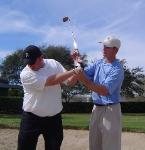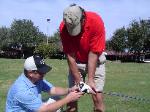
| Flexibility Exercises |


| SouthPaw Golf Academy |

TIPS
| The Leaders in Left-handed Golf Instruction |
Presented by Seth Glasco and Nick Kumpis
BE TWICE AS GOOD BY USING HALF OF THE WHOLE
You may have been promised that there would be no math involved with
this game, other than adding up your score at the end of a round, but bear
with me on this one...
Golf is, as you know, a very difficult game to learn. Those of us who teach
the game thank the golf gods each and every day for this fact, as we all
have managed to get to our respective stages in life without having to get
a real job. In my humble opinion, one of the most glaring difficulties is that
we are asking a left-handed person to control the position of the clubface
through impact with their right hand and arm. Most true lefties spend their
whole lives ruling their worlds with their left hands, while the right arm
hangs at their sides like dead weight. Don’t let yourself fall into that trap
when it comes to your golf swing.
Two common traits that all good players share is the ability to control the
position in and direction of the clubface through impact and make solid
contact with the golf ball. If you begin developing your strength and
coordination with your “weaker” arm, you will start to see improvements in
your ball-striking very soon. Remember, with all full swing drills your goal
is to be able to create the proper technique, not see how far you can hit it,
so keep your pace under control. Here’s how to do it:
-Put a tee in the ground, like you were about to hit a driver
-Using a 7-iron, take your normal address position
-Take your left hand off the club and place it behind your back
-Swing back until your right arm is parallel to the ground, making sure that
the clubshaft is pointing straight up to the sky
-Swing down and knock the tee out of the ground, making sure to keep
your
right elbow close to your side on your through-swing. Again, the shaft
should be vertical.
-When you can hit the tee consistently, place a ball on the tee. As your
contact improves, slowly lower the tee until it is at a “par-3” height. You
should eventually be able to hit the ball 50 to 75 yards with just one arm.
-Continue this drill until you win a U.S. Open or I call you and tell you to
stop, whatever comes first.
this game, other than adding up your score at the end of a round, but bear
with me on this one...
Golf is, as you know, a very difficult game to learn. Those of us who teach
the game thank the golf gods each and every day for this fact, as we all
have managed to get to our respective stages in life without having to get
a real job. In my humble opinion, one of the most glaring difficulties is that
we are asking a left-handed person to control the position of the clubface
through impact with their right hand and arm. Most true lefties spend their
whole lives ruling their worlds with their left hands, while the right arm
hangs at their sides like dead weight. Don’t let yourself fall into that trap
when it comes to your golf swing.
Two common traits that all good players share is the ability to control the
position in and direction of the clubface through impact and make solid
contact with the golf ball. If you begin developing your strength and
coordination with your “weaker” arm, you will start to see improvements in
your ball-striking very soon. Remember, with all full swing drills your goal
is to be able to create the proper technique, not see how far you can hit it,
so keep your pace under control. Here’s how to do it:
-Put a tee in the ground, like you were about to hit a driver
-Using a 7-iron, take your normal address position
-Take your left hand off the club and place it behind your back
-Swing back until your right arm is parallel to the ground, making sure that
the clubshaft is pointing straight up to the sky
-Swing down and knock the tee out of the ground, making sure to keep
your
right elbow close to your side on your through-swing. Again, the shaft
should be vertical.
-When you can hit the tee consistently, place a ball on the tee. As your
contact improves, slowly lower the tee until it is at a “par-3” height. You
should eventually be able to hit the ball 50 to 75 yards with just one arm.
-Continue this drill until you win a U.S. Open or I call you and tell you to
stop, whatever comes first.
CHIPPING SHOULD BE A DRAG
that lands on the green near the edge closest to the player, then rolls the quite
close enough to use a putter. Chipping, by definition, is a low running shot that
lands on the green near the edge closest to the player, then rolls the remaining
distance towards the hole, much like a putt would.
remaining distance towards the hole, much like a putt would.
The best way to develop a good chipping game is to master a very simple shot I
like to call a “lofted putt”. The swing motion of the shot is almost identical to a
putting stroke, but we replace the putter with a lofted club. Start off using a 7 or
8 iron, then experiment with different clubs. You can use every club in your bag
(with exception of the driver) to create an endless array of flight to roll
combinations, adding several shots to your short game arsenal with only one set
of mechanics. Follow these simple steps and soon your friends will be referring
to you as “Chipper”...
- Using your putting grip, position the ball in the center of your stance and get
as close to the ball as possible. You will need to slide your hands down the grip
to make the shaft as upright as possible, and always make sure the ball is sitting
up nicely with this shot.
- Lean 70% of your weight on your right side, so you can see the front of the
ball out of your left eye.
- Keeping your body as still as you can, use your arms and clubshaft to make a
pendulum-like putting motion.
- Because you are leaning to the right, your sternum will be closer to the
target than the clubhead, ensuring that the club is moving downward through
impact. You will also see very little follow through if done correctly, as the
ground and golfball will slow the club down after impact.
- Feel as though you are dragging the grip-end through impact with your right
arm, rather than pushing the head end through with your left hand. Like in
putting, your pace should be rhythmic and unhurried, and there should be as
little wrist movement as possible.
close enough to use a putter. Chipping, by definition, is a low running shot that
lands on the green near the edge closest to the player, then rolls the remaining
distance towards the hole, much like a putt would.
remaining distance towards the hole, much like a putt would.
The best way to develop a good chipping game is to master a very simple shot I
like to call a “lofted putt”. The swing motion of the shot is almost identical to a
putting stroke, but we replace the putter with a lofted club. Start off using a 7 or
8 iron, then experiment with different clubs. You can use every club in your bag
(with exception of the driver) to create an endless array of flight to roll
combinations, adding several shots to your short game arsenal with only one set
of mechanics. Follow these simple steps and soon your friends will be referring
to you as “Chipper”...
- Using your putting grip, position the ball in the center of your stance and get
as close to the ball as possible. You will need to slide your hands down the grip
to make the shaft as upright as possible, and always make sure the ball is sitting
up nicely with this shot.
- Lean 70% of your weight on your right side, so you can see the front of the
ball out of your left eye.
- Keeping your body as still as you can, use your arms and clubshaft to make a
pendulum-like putting motion.
- Because you are leaning to the right, your sternum will be closer to the
target than the clubhead, ensuring that the club is moving downward through
impact. You will also see very little follow through if done correctly, as the
ground and golfball will slow the club down after impact.
- Feel as though you are dragging the grip-end through impact with your right
arm, rather than pushing the head end through with your left hand. Like in
putting, your pace should be rhythmic and unhurried, and there should be as
little wrist movement as possible.

